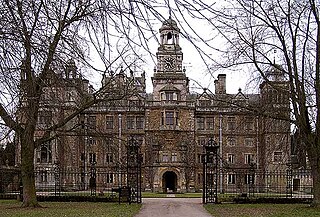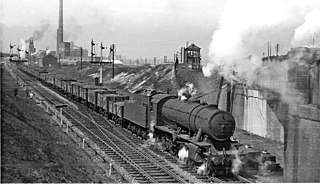Related Research Articles

Hackenthorpe is a village 5 miles south east of Sheffield’s city centre, now classed as a historic township of the city. Due to much expansion, the village became a part of Sheffield city during the 1950s. During much of the late 19th and 20th centuries the village was noted for its steelmaking, with the Thomas Staniforth & Co Sickle works being based at Main Street. Another prominent feature of the village is the 17th century Hackenthorpe Hall, built by John Newbould for the Hounsfield family, with James Hounsfield being a prominent land owner. The building is today used as a nursery.

The areas of Sheffield, a city and metropolitan borough in the north of England, vary widely in size and history. Some of the areas developed from villages or hamlets, that were absorbed into Sheffield as the city grew, and thus their centres are well defined, but the boundaries of many areas are ambiguous. The areas of Sheffield do not play a significant administrative role, but the city is divided into 28 electoral wards for local elections and 6 parliamentary constituencies for national elections.

The Dukeries is an area of the county of Nottinghamshire so called because it contained four ducal seats. It is south of Worksop, which has been called its "gateway". The area was included within the ancient Sherwood Forest. The ducal seats were:

Woodhouse railway station, is a railway station serving Woodhouse and Woodhouse Mill in Sheffield, South Yorkshire, England. The station is 5.25 miles (8 km) east of Sheffield station on the Sheffield to Lincoln Line.

Orgreave Colliery was a coal mine situated adjacent to the main line of the Manchester, Sheffield and Lincolnshire Railway about 5 miles (8 km) east of Sheffield and 3.5 miles (6 km) south west of Rotherham. The colliery is within the parish of Orgreave, from which it takes its name.
Orgreave Colliery platform was a workman's halt built to serve the miners working at Orgreave Colliery in South Yorkshire, England. These workmen's trains or "Paddy Mails" were operated between Sheffield Victoria and Treeton Colliery at shift change times being hauled along the main line to Orgreaves Colliery Sidings where the main line locomotive was exchanged for one belonging to the colliery company, usually "Rothervale No.6" which was fitted with vacuum brakes.

The Birley Collieries were a group of coal mines set in the Shire Brook Valley in south east Sheffield, South Yorkshire, England. They were connected to the railway system by a branch line from the Manchester, Sheffield and Lincolnshire Railway at Woodhouse East Junction, about 800 yards east of Woodhouse station.
The United Steel Companies was a steelmaking, engineering, coal mining and coal by-product group based in South Yorkshire and Lincolnshire, England.
Treeton Colliery was a coal mine situated in the village of Treeton, near Rotherham, South Yorkshire, England.

Rother Vale Collieries were a group of coal producing pits originally in the Rother Valley parishes of Treeton, Woodhouse and Orgreave, nowadays on the south east Sheffield / Rotherham boundary, in South Yorkshire, England. In the early 20th century a new colliery at Thurcroft was developed.
Tinsley Park Collieries were a group of coal mines situated in the Tinsley / Darnall area to the east of the City of Sheffield, South Yorkshire, England.
Kilnhurst Colliery, formerly known as either Thrybergh or Thrybergh Hall Colliery, was situated on the southern side of the village of Kilnhurst, near Rotherham, South Yorkshire, England.

Kiveton Park Colliery was a coal mine in the village of Kiveton Park, near Rotherham, South Yorkshire, England.
High Hazels Colliery was a coal mine situated between the parish of Catcliffe, near Rotherham, and the parish of Handsworth, near Sheffield. It was adjacent to the main line of the Manchester, Sheffield and Lincolnshire Railway between the stations of Darnall and Woodhouse.

To develop coal seams in the area, the Sheffield Coal Company opened a new colliery between Swallownest and Beighton, at that time on the borders of Rotherham Rural District and Derbyshire but now just within the borough of Rotherham. The company, which became part of the United Steel Companies in 1937, already owned other collieries in the area, particularly the Birley Collieries and that at Aston Common, known as North Staveley Colliery.
Aston Colliery was a small coal mine sunk on Aston Common, within Rotherham Rural District but six miles east of Sheffield in the 1840s. In 1864 its workings were taken over and developed by the North Staveley Colliery Company, part of the Staveley Coal and Iron Company, based in North Derbyshire. It was later acquired by the Sheffield Coal Company.

Shire Brook is a small stream in the south eastern part of the City of Sheffield in South Yorkshire, England. It rises in the suburb of Gleadless Townend and flows in a general easterly direction for 4 miles (6.5 km) to its confluence with the River Rother between Beighton and Woodhouse Mill. In the past the brook has been both the border of Yorkshire and Derbyshire and between the sees of Canterbury and York. The course of the stream has been influenced by human intervention in the 20th century with the brook being diverted underground and flowing through culverts on three occasions as it traverses locations which were formerly landfill sites and extensive railway sidings.

Manvers Main Colliery was a coal mine, sunk on land belonging to the Earl Manvers on the northern edge of Wath-upon-Dearne, between that town and Mexborough in the Dearne Valley, in the West Riding of Yorkshire, England. The regional headquarters and laboratories of British Coal were situated in the complex.

Beighton is a village 6 miles south-east of Sheffield’s city centre, now classed as a historic township of the city. Due to much expansion, the village became a part of Sheffield city in 1967, which also saw it transfer from Derbyshire to the newly created South Yorkshire, England. During much of the late 17th to 19th centuries the village was noted for its steelmaking, with Thomas Staniforth & Co Sickle works being based at nearby Hackenthorpe.
Beighton Junction is a set of railway junctions near Beighton on the border between Derbyshire and South Yorkshire, England.
References
- Barnett, A.L., "Railways of the South Yorkshire Coalfield from 1880", R.C.T.S., 1984. ISBN 0-901115-58-4
- Papers of the Sheffield Coal Company
- Various issues of company newspapers.